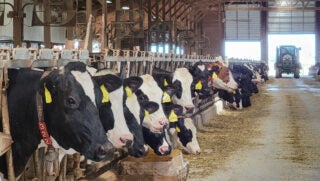PETA is at it again, and the center of their attention is Wyoming’s Cowboy State license plate. Their suggestion is to replace the iconic bucking horse and rider, with one option being a dinosaur skull.
On Thursday, PETA sent a letter to Republican state Sen. Ogden Driskill and Republican House Speaker Albert Sommers requesting that residents opt out of buying the “rodeo-glorifying” license plate design.
Current laws require that the logo be on all of the state’s 19 license plate options.
To make it “easier” for lawmakers, PETA has offered three alternatives:
First, a triceratops skull, which presumably references a large haul of triceratops fossils found there in the early 2010s.

Second, a horse running “free” in nature — no saddle, no rider, just pure, unbridled freedom.

And for those who insist on keeping a rodeo theme, PETA suggests a more “honest” depiction: a spur dripping blood. Talk about subtlety.

In a news release, PETA states that the bucking horse should “go by the way of the dinosaur.” The group has long lobbied against rodeo (and, well, any sport or agricultural use of animals).
PETA is adamant that the current design promotes animal cruelty. They cite the deaths of two horses at the Overland Stage Stampede Rodeo in Green River as evidence of the sport’s inherent brutality. Ingrid Newkirk, PETA’s president, insists that Wyomingites should celebrate the state’s “thrilling Jurassic history” or its wild mustangs rather than “cruel” rodeos.
Wyoming’s bucking horse isn’t just a random silhouette on a license plate. It’s a symbol steeped in history, first appearing as far back as 1918 and serving as an insignia for the Wyoming National Guard during World War I. Many believe it represents Steamboat, a legendary rodeo horse renowned for being “the horse that couldn’t be ridden.”
In 1935, to tackle the issue of rampant counterfeiting of Wyoming’s license plates, Secretary of State Lester Hunt proposed new legislation. He enlisted Allen T. True from Littleton, Colorado, to create a fresh design. True’s creation featured the now-famous Bucking Horse and Rider, which made its debut on Wyoming’s license plates in 1936. This distinctive design helped solidify the plates’ authenticity and would go on to become an enduring symbol of the state.
The bucking horse and rider are also on the state seal and are the University of Wyoming’s logo.

Democratic State Sen. Mike Gierau was copied on the letter from PETA and told Cowboy State Daily that he simply responded to the organization saying, “Thanks for sharing.”
Rodeo in Wyoming history
Rodeo is a deeply ingrained part of Wyoming’s culture and heritage, earning the state its well-deserved nickname, “The Cowboy State.” The sport’s roots in Wyoming date back to the late 19th and early 20th centuries, reflecting the region’s strong ranching and cowboy traditions.
One of the most famous rodeos in Wyoming is Cheyenne Frontier Days, known as the “Daddy of ’em All.” Established in 1897, this event is one of the largest and oldest outdoor rodeos in the world. Held annually in late July, it attracts top rodeo athletes from around the globe, as well as thousands of spectators. The event features a variety of competitions, including bull riding, bronc riding, steer wrestling, and barrel racing, along with parades, concerts, and other festivities.
Other notable rodeos in Wyoming include the Cody Stampede Rodeo, held every summer in Cody, and the Sheridan WYO Rodeo in Sheridan. These events highlight the state’s commitment to preserving its cowboy culture and provide opportunities for both participants and visitors to experience the excitement and tradition of rodeo firsthand.
»Related: The complicated discussion about animal welfare at rodeos


